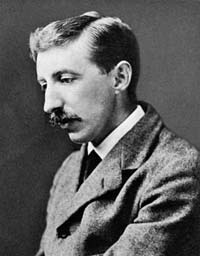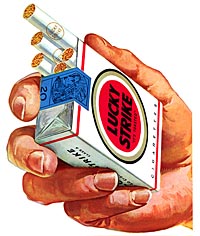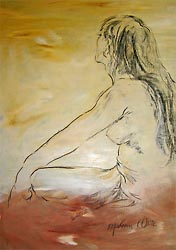|
Biographical Log of Michael Furstner - Page 119
2008 ||
2009 :
Jan |
Feb |
Mar |
Apr |
May |
Jun |
Jul |
Aug |
Sep |
Oct |
Nov |
Dec | Page :
Previous |
Next |
Most Recent -
Next -
Previous -
Page 1 -
Photos -
Index -
Topics -
MP3s -
Jazclass Links
Wednesday & Thursday, October 21 & 22 2009
(diary)
 A single simply idea is like a seed, from which new thoughts, discoveries,
awarenesses can grow into different directions like the branches of a tree.
A single simply idea is like a seed, from which new thoughts, discoveries,
awarenesses can grow into different directions like the branches of a tree.
Here is such an idea from E M Forster as expressed in his (1910)
novel Howards End :
"Under cosmopolitanism, if it comes, we shall receive no help from the
earth. Trees and meadows and mountains will only be a spectacle, and the
binding force that they once exercised on character must be entrusted to Love
alone. May Love be equal to the task."
For centuries populations, communities, families, lived generation after
generation after generation in the same place, sometimes even in the same home.
Life was determined and individual "character" was formed by the so familiar,
surrounding landscape, not merely a backdrop but rather the backbone of the
community.
From the days of Columbus however this gradually started to change.
First by trickles of emigration to the Americas, later Australia, and by the
administration of conquered colonies in the underdeveloped world. Then, during
the industrial revolution, came the exodus from the country to the cities, and
finally after the two World Wars the massive movements over international and
global distances facilitated by cheap air travel.
I have experienced this shift (from "place" to "Love") in my own personal life
too. From my childhood up to my 29th year Martinshof was always my home
base, my "anchor" to the world. I knew every rabbit track, blackberry bush,
mushroom spot, chestnut tree in our woods and was on intimate terms with several
trees I loved to climb in.
 Then (in 1965) I lifted anchor and with my wife and young daughter migrated to
Australia. Instantly Martinshof became a distant memory and my new anchor in
life truly became my family (after a few years extended to 4 through the birth
of our son). We became a tightly knit loving unit, and as long as we were together
that was "home", no matter where we were at the time. During the next 15 years
of our marriage we shifted half a dozen times over huge distances and into wildly
different environments. We enjoyed all these new places, because we were
together.
Then (in 1965) I lifted anchor and with my wife and young daughter migrated to
Australia. Instantly Martinshof became a distant memory and my new anchor in
life truly became my family (after a few years extended to 4 through the birth
of our son). We became a tightly knit loving unit, and as long as we were together
that was "home", no matter where we were at the time. During the next 15 years
of our marriage we shifted half a dozen times over huge distances and into wildly
different environments. We enjoyed all these new places, because we were
together.
"Cosmopolitanism", as Forster defines it, is here to stay. But have we
really abandoned the earth and rely on Love alone to nourish our character ? I
don't believe so. Rather than tightly holding onto (tying ourselves to) one
small spot on earth, approaching the stationary existence of a tree, we have
changed our lifestyle of a nature halfway towards those of migratory birds, or
whales which roam the world over vast distances.
Rather than exposing our
"character" to just one relatively small area on earth, we are now able to be
influenced by as much of the world as we desire. In the process we are becoming
the wiser and more aware for it, as well as becoming more reliant on the "love"
for our fellow man. That will ultimately become a good thing for all of
us.
Most Recent -
Next -
Previous -
Top -
Page 1 -
Photos -
Index -
Topics -
MP3s -
Jazclass Links
Friday, October 23 2009
(diary)
Back in the 1940s and 50s, when smoking was as yet not recognised as a health
hazard (although I privately sometimes wondered), there was etiquette and much
romance surrounding cigarettes and tobacco. Just after the war (WW2) cigarets
(together with American chewing gum) were a prized luxury much in demand by just
about everybody.
Cigarets had magical names, for us in Holland especially English (Craven A,
Players, Senior Service, Pall Mall)
and American brands (Chesterfield, Lucky Strike, Camel), but these overseas brands were very expensive and I always stuck to the more mondain local brands (Roxy, Peter Stuyvesant) or rolled my own from the (sailor's favourite) strong, dark, stringy "haar van de weduwe" (the widow's hair) manufactured by Douwe Egberts.
Stories from Galicia 2 continues from October 21, 2008
Later, at Leiden in our University Students Corps, we were taught etiquette
rules about smoking with stringent DOs and DON'Ts which could make or break your
image amongst your peers.
- Never light a cigarette with a lighter, always use matches.
- Never place burnt out matches back in their box, always throw them
away.
-
Never hold a cigaret in your mouth while lighting someone elses
cigaret.
 As a Geology student in Spain I thoroughly enjoyed the shear romance
surrounding cigarets.
As a Geology student in Spain I thoroughly enjoyed the shear romance
surrounding cigarets.
The cheapest Spanish brand on the market was
Celtas, cigarets of very roughly cut tobacco (frequently including
tobacco leaf veins) rolled in yellowish paper (like these Gitanes on the
adjacent photo).
I quite liked these, smoked them most of the time, and once
caused considerable consternation and commentary from my fellow students when I
offered one to our Professor Emile den Tex when he visited us on his
annual inspection tour in Galicia.
Next in hierarchy were Gitanes (in
either white or yellow paper), the Spanish equivalent in style and taste to the
French Gauloises. The up market Spanish national brand was Bisonte
contained in a glossy, American style package, quite acceptable in
taste.
The ultimate in smoking ecstasy in Spain however were
American cigarets (Chesterfield, Lucky Strike and Camel), not imported
through the regular channels but smuggled in as contraband by the numerous
vessels arriving at the various small ports on Spain's North coast. These were
exclusively sold "under the counter" in every self respecting pub in the
country (and much cheaper than in Holland).
For me there was no greater joy than to casually lean on the bar
counter, wink at the bar man with a knowing look and then whisper behind my
hand "Chester por favor". Upon which the barman, after a cautious quick
look left and right, would reach under the counter and, covered under the palm
of his hand, offer me a packet of Chesterfield.
 But wait, there is more !! If buying a packet of "Chester" or
"Lucky" was Heaven, lighting a cigaret in Spain was almost as
good.
But wait, there is more !! If buying a packet of "Chester" or
"Lucky" was Heaven, lighting a cigaret in Spain was almost as
good.
The two most prized possessions (in those days) of any country Spaniard
and us Geology students alike, were his botta and his labourer's
lighter (Spanish name ?? I forgot).
Bottas then were the genuine pigskin article (not those horrible plastic tourist
ones you buy today), the skin turned inside out, with the bristles tarred. You
needed to cure the inside with red wine for a week or so before the tar taste had
disappeared and the wine was drinkable, but after that the botta would last you
for a lifetime of pleasure (provided you kept it filled and not let dry out).
The labourer's lighter was a magical instrument. It consisted of a thin
hollow brass (?) rod, just over half a centimeter in diameter and 5 cm (2
inches) high. On top of it, on the side was a 1cm diameter toothed wheel, which,
when struck with a flat hand, produced a spark from the metal flint underneath
that ignited the top of the wick protruding from the hollow rod. You blew on the
wick to increase its ember with which you then lighted your cigaret. The wick
was typically 50-60 cm (2 feet) long and encased in a tight yellow mashed
"stocking". You rolled the wick in a special way in a coil so that it did not extend
longer than about 8 cm (3 inches) from underneath the lighter's metal rod. As you used the lighter the wick (and coil) would reduce in length over time.
My road labourer friend Peppe (who was in charge of a 7 km stretch of
dirt road halfway between Carballo and Santiago de Compostela) always proudly
called his lighter contra viento y marea ("against wind and weather"),
which indeed it was.
Back in Holland us Geology students would always carry our contra viento
in our pockets at official balls, and, dressed in immaculate black
tails, light our ladies' cigarets with it with great showmanship and pride. Our contra vientos
were always considered well above the otherwise strict etiquette rules.
For over 20 years I carried with me from those days the cover of an empty packet
of Lucky Strikes on which (in 1959) a lovely and very attractive Spanish
young lady which I met at a Fiesta in Caión, had written her name : Maria Luz Pet Morales. After that wonderful
Fiesta (now 50 years ago) I never met her again.
Stories from Galicia continues on November 24, 2009
Most Recent -
Next -
Previous -
Top -
Page 1 -
Photos -
Index -
Topics -
MP3s -
Jazclass Links
Saturday & Sunday, October 24 & 25 2009
(diary)
 Yesterday's story was brought on from reading another one of Arturo Pérez-Reverte's adventure novels, The
Nautical Chart, in which he refers to Celtas cigarettes as well as
the labourer's lighter I attempted to describe in my Blog.
Yesterday's story was brought on from reading another one of Arturo Pérez-Reverte's adventure novels, The
Nautical Chart, in which he refers to Celtas cigarettes as well as
the labourer's lighter I attempted to describe in my Blog.
One of the secondary characters in the book is an old dyed in the wool sailor,
El Piloto, who at several instances in the story expresses his wisdom
about women, largely based on his experiences in the numerous bars and brothels
he had visited throughout the world during his life.
 They are of a crude sailor's humour and of course over generalised in
nature, but they do reflect some devastatingly bold thoughts worth
contemplating. They are of a crude sailor's humour and of course over generalised in
nature, but they do reflect some devastatingly bold thoughts worth
contemplating.
I will give you two of El Piloto's observations, made by him
as well as by me now here, with feelings of goodwill, love and (often) awe for
women in general, without any ill intention. Here is the first one :
"There aren't any bad women. Just like there aren't any
bad boats . . . . It's the men on board who make them one way or the
other."
There is (in my view) certainly considerable truth in this statement. In humans,
like most animal species on earth, it are by nature and evolution the males who
dominate the females and as a consequence can have defining influence and effect
on the building and nature of a female's character. The interesting
question I immediately ask myself then is : "Where do bad men come from, are they born that way
?"
In general I certainly don't believe that is so. Instead in nature (within the
natural force field of species propagation and evolution : "survival of the
fittest") it are the males who compete (and where required) fight with one
another for the right to mate with females. This creates inherent deep rooted
insecurity in many males, which in turn makes them prone (influenced by
living environment or male peer group) to become bad bullies or (physically,
sexually or mentally) abusive of females.
Here is El Piloto's second (sorry, very crude) observation :
"There are women," he maintains "who have strange ideas in their head, like others have
gonorrhea. And what they do is come along and give it to
you."
Once you have recovered and can look beyond the coarseness of El Piloto'sstatement,
you may perhaps become aware of an example of its fundamental
proposition. I, for one, have no farther to look than, surprise surprise, my
very own mother.
 After my father's sudden death in 1981, my mother on several occasions
repeatedly impressed on me that it had been she (and not my father) who
had had the political National Socialistic ideals prior to and during
World War 2.
After my father's sudden death in 1981, my mother on several occasions
repeatedly impressed on me that it had been she (and not my father) who
had had the political National Socialistic ideals prior to and during
World War 2.
My father (she said) had largely out of solidarity and love
for her joined the Dutch National Socialist Party (the NSB), resulting in
imprisonment in concentration camps immediately after the war and subsequent
social retributions which to some degree continued for the rest of their
lives.
My mother grew up as a young woman amongst the German euphoria and regained National
pride under Adolf Hitler's National Socialist rule during the 1930s. It
was, especially for young people, a wonderful time full of ideals and National
purpose. My mother, as captain of the local women's hockey team,
traveling all around the country prior to the 1936 Olympic Games, felt, I am
sure, an integral part of it.
My father, through his lengthy stays in London, Paris and Germany,
must have seen the difference between the still depressed UK and France and the
bustling and thriving new Germany. But, after long contemplation over many
years, I now do believe that my mother was right, and that it was she
(above all) who induced him to take sides in 1939. My father, although
idealistic in nature, was never a very politically minded type of person.
Comments -
Most Recent -
Next Page -
Previous -
Top -
Page 1 -
Photos -
Index -
Topics -
Jazclass Links
Copyright © 2009 Michael Furstner
|


 As a Geology student in Spain I thoroughly enjoyed the shear romance
surrounding cigarets.
As a Geology student in Spain I thoroughly enjoyed the shear romance
surrounding cigarets. But wait, there is more !! If buying a packet of "Chester" or
"Lucky" was Heaven, lighting a cigaret in Spain was almost as
good.
But wait, there is more !! If buying a packet of "Chester" or
"Lucky" was Heaven, lighting a cigaret in Spain was almost as
good.

